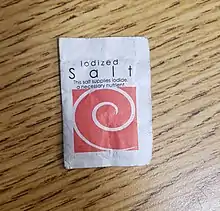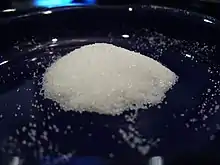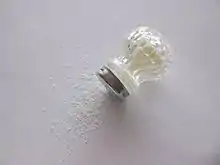Iodised salt
Iodised salt (also spelled iodized salt) is table salt mixed with a minute amount of various salts of the element iodine. The ingestion of iodine prevents iodine deficiency. Worldwide, iodine deficiency affects about two billion people and is the leading preventable cause of intellectual and developmental disabilities.[1][2] Deficiency also causes thyroid gland problems, including endemic goitre. In many countries, iodine deficiency is a major public health problem that can be cheaply addressed by purposely adding small amounts of iodine to the sodium chloride salt.


Iodine is a micronutrient and dietary mineral that is naturally present in the food supply in some regions, especially near sea coasts but is generally quite rare in the Earth's crust since iodine is a so-called heavy element, and abundance of chemical elements generally declines with greater atomic mass. Where natural levels of iodine in the soil are low and the iodine is not taken up by vegetables, iodine added to salt provides the small but essential amount of iodine needed by humans.
An opened package of table salt with iodide may rapidly lose its iodine content in high temperature and high relative humidity conditions through the process of oxidation and iodine sublimation.[3]
Chemistry, biochemistry and nutritional aspects

Four inorganic compounds are used as iodide sources, depending on the producer: potassium iodate, potassium iodide, sodium iodate, and sodium iodide. Any of these compounds supplies the body with its iodine required for the biosynthesis of thyroxine (T4) and triiodothyronine (T3) hormones by the thyroid gland. Animals also benefit from iodine supplements, and the hydrogen iodide derivative of ethylenediamine is the main supplement to livestock feed.[4]
Salt is an effective vehicle for distributing iodine to the public because it does not spoil and is consumed in more predictable amounts than most other commodities. For example, the concentration of iodine in salt has gradually increased in Switzerland: 3.75 mg/kg in 1952, 7.5 mg/kg in 1962, 15 mg/kg in 1980, 20 mg/kg in 1998, and 25 mg/kg in 2014.[5] These increases were found to improve iodine status in the general Swiss population.[6]
Salt that is iodized may slowly lose its iodine content by exposure to excess air over long periods.[7]
Production
Edible salt can be iodised by spraying it with a potassium iodate or potassium iodide solution. 57 grams of potassium iodate, costing about US$1.15 (in 2006), is required to iodise a ton (2,000 pounds) of salt.[1] Dextrose is added as a stabilizer to prevent potassium iodide from oxidizing and evaporating. Anti-caking agents such as calcium silicate are commonly added to table salt to prevent clumping.[8]
In public health initiatives

Worldwide, iodine deficiency affects two billion people and is the leading preventable cause of intellectual and developmental disabilities.[1][2] According to public health experts, iodisation of salt may be the world's simplest and most cost-effective measure available to improve health, only costing US$0.05 per person per year.[1] At the World Summit for Children in 1990, a goal was set to eliminate iodine deficiency by 2000. At that time, 25% of households consumed iodised salt, a proportion that increased to 66% by 2006.[1]
Salt producers are often, although not always, supportive of government initiatives to iodize edible salt supplies. Opposition to iodization comes from small salt producers who are concerned about the added expense, private makers of iodine pills, concerns about promoting salt intake, and unfounded rumors that iodization causes AIDS or other illnesses.[1]
The United States Food and Drug Administration recommends[9] 150 micrograms (0.15 mg) of iodine per day for adults.
Argentina
Since 8 May 1967 salt for human or animal use must be iodised, according to the Law 17,259.[10]
Syria
In the end of eighties of last century, a Syrian endocrinologist Samir Ouaess conducted a research on hypothyroidism and noticed that 90 percent of Syrians suffer from hypothyroidism, 50 percent suffer from health problems as a result of Thyroid deficiency, and 10 percent of students suffer from a decline in their academic level due to that problem. Dr. Ouaess linked these results with the fact that natural drinking water sources in Syria do not contain enough minerals. He presented the result of that study to the Syrian Ministry of Health. After that, adding iodine to salt became almost mandatory till 2021, when the Syrian government canceled the iodization of salt and as a result of economic problems related to economic sanctions.
Australia
Australian children were identified as being iodine deficient in a survey conducted between 2003 and 2004.[11] As a result of this study the Australian Government mandated that all bread with the exception of "organic" bread must use iodised salt.[12] There remains concern that this initiative is not sufficient for pregnant and lactating women.[13]
Brazil
Iodine Deficiency Disorders were detected as a major public health issue by Brazilian authorities in the 1950s when about 20% of the population had a goitre.[14] The National Agency for Sanitary Vigilance (ANVISA) is responsible for setting the mandatory iodine content of table salt. The Brazilian diet averages 12 g of table salt per day, more than twice the recommended value of 5 g a day. To avoid excess consumption of iodine, the iodizing of Brazilian table salt was reduced to 15–45 mg/kg in July 2013. Specialists criticized the move, saying that it would be better for the government to promote reduced salt intake, which would solve the iodine problem as well as reduce the incidence of high blood pressure.[15]
Canada
Salt sold to consumers in Canada for table and household use must be iodized with 0.01% potassium iodide. Sea salt and salt sold for other purposes, such as pickling, may be sold uniodized.[16]
China
Much of the Chinese population lives inland, far from sources of dietary iodine. In 1996, the Chinese Ministry of Public Health estimated that iodine deficiency was responsible for 10 million cases of intellectual developmental disorders in China.[17] The Chinese government had held a legal monopoly on salt production since 119 BCE and began iodizing salt in the 1960s, but market reforms in the 1980s led to widespread smuggling of non-iodized salt from private producers. In the inland province of Ningxia, only 20% of salt consumed was sold by the China National Salt Industry Corporation. The Chinese government responded by cracking down on smuggled salt, establishing salt police with 25,000 officers to enforce the salt monopoly. Consumption of iodized salt reached 90% of the Chinese population by 2000.[18]
India
India and all of its states ban the sale of non-iodized salt for human consumption. However, implementation and enforcement of this policy are imperfect; a 2009 survey found that 9% of households used non-iodized salt and that another 20% used insufficiently iodized salt.[19]
Iodised salt was introduced to India in the late 1950s. Public awareness was increased by special programs and initiatives, both governmental and nongovernmental. As of now, iodine deficiency is only present in a few isolated regions which are still unreachable. In India, some people use Himalayan rock salt. Rock salt however is low in iodine and should be consumed only when there are other iodine-rich foods in diet.
Kazakhstan
Kazakhstan, a country in Central Eurasia in which local food supplies seldom contain sufficient iodine, has drastically reduced iodine deficiency through salt iodization programs. Campaigns by the government and non-profit organizations to educate the public about the benefits of iodized salt began in the mid-1990s, with iodization of edible salt becoming legally mandatory in 2002.[1]
Nepal
The Salt Trading Corporation has been distributing Iodized Salt in Nepal since 1963.[20] 98% of the Population uses Iodized Salt. Utilising non-Iodised salt for human consumption is prohibited. Salt costs about US$0.27 a Kilo.[21]
Philippines
On December 20, 1995, Philippine President Fidel V. Ramos signed Republic Act 8172: An Act for Salt Iodization Nationwide (ASIN).[22]
Romania
According to the 568/2002 law signed by the Romanian parliament and republished in 2009, since 2002 iodized salt is distributed mandatory in the whole country. It is used mandatory on the market for household consumption, in bakeries, and for pregnant women. Iodised salt is optional though for animal consumption and the food industry, although widely used. The salt iodization process has to assure a minimum of 30mg iodine/kg of salt. [23][24]
South Africa
The South African government instructed that all salt for sale was to be iodised after December 12, 1995.[25][26]
United States
Iodized salt is not mandatory in the US but it is widely available.
In the U.S. in the early 20th century, goitres were especially prevalent in the region around the Great Lakes and the Pacific Northwest.[27] David Murray Cowie, a professor of paediatrics at the University of Michigan, led the U.S. to adopt the Swiss practice of adding sodium iodide or potassium iodide to table and cooking salt. On May 1, 1924, iodised salt was sold commercially in Michigan.[28] By the fall of 1924, Morton Salt Company began distributing iodised salt nationally.
A 2017 study found that the introduction of iodized salt in 1924 raised the IQ for the one-quarter of the population most deficient in iodine.[29] These findings "can explain roughly one decade's worth of the upward trend in IQ in the United States (the Flynn effect)".[29] The study also found "a large increase in thyroid-related deaths following the countrywide adoption of iodized salt, which affected mostly older individuals in localities with high prevalence of iodine deficiency".[29] A 2013 study found a gradual increase in average intelligence of 1 standard deviation, 15 points in iodine-deficient areas and 3.5 points nationally after the introduction of iodized salt.[30]
A 2018 paper found that the nationwide distribution of iodine-fortified salt increased incomes by 11%, labor force participation by 0.68 percentage points and full-time work by 0.9 percentage points. According to the study, "These impacts were largely driven by changes in the economic outcomes of young women. In later adulthood, both men and women had higher family incomes due to iodization."[31]
No-additive salts for canning and pickling
In contrast to table salt, which often contains iodide as well as anti-caking ingredients, special canning and pickling salt is made for producing the brine to be used in pickling vegetables and other foodstuffs. Contrary to popular belief, however, iodized salt affects neither color, taste, nor consistency of pickles.[32]
Fortification of salt with other elements
Double-fortified salt (DFS)
Salt can also be double-fortified with iron and iodine.[33] The iron is microencapsulated with stearin to prevent it from reacting with the iodine in the salt. By providing iron in addition to iodine in the convenient delivery vehicle of salt, it could serve as a sustainable approach to combating both iodine and iron deficiency disorders in areas where both deficiencies are prevalent.[34]
Adding iron to iodized salt is complicated by several chemical, technical, and organoleptic issues. Since a viable DFS premix became available for scale-up in 2001, a body of scientific literature has been emerging to support the DFS initiative including studies conducted in Ghana, India, Côte d'Ivoire, Kenya and Morocco.[35]
Fluoridated salt
In some countries, table salt is treated with potassium fluoride to enhance dental health.[36]
Diethylcarbamazine
In India and China, diethylcarbamazine has been added to salt to combat lymphatic filariasis.[37]
See also
- Basil Hetzel
- Enriched flour serves an analogous function to "enriched salt".
- History of salt
- Lugol's iodine
- Sea salt
- Water fluoridation, a similar public health intervention
- Food fortification
Notes
- McNeil, Donald G. Jr (2006-12-16). "In Raising the World's I.Q., the Secret's in the Salt". New York Times. Retrieved 2008-12-04.
- The Lancet (12 July 2008). "Iodine deficiency—way to go yet". The Lancet. 372 (9633): 88. doi:10.1016/S0140-6736(08)61009-0. PMID 18620930. S2CID 5416860. Retrieved 2014-12-10.
- Diosady, L. L., and M. G. Venkatesh Mannar. "Stability of iodine in iodized salt". 8th World Salt Symposium. Amsterdam: Elsevier. 2000.
- Phyllis A. Lyday "Iodine and Iodine Compounds" in Ullmann's Encyclopedia of Industrial Chemistry, Wiley-VCH, Weinheim, 2005. doi:10.1002/14356007.a14_381.
- "Sel de cuisine : hausse du taux d'enrichissement en iode" (in French). Swiss Federal Administration. Retrieved 8 January 2014.
- Michael B Zimmermann; Isabelle Aeberli; Toni Torresani; Hans Bürgi (August 2005). "Increasing the iodine concentration in the Swiss iodized salt program markedly improved iodine status in pregnant women and children: a 5-y prospective national study". American Journal of Nutrition. 82 (2): 388–392. doi:10.1093/ajcn.82.2.388. PMID 16087983.
- Katarzyna Waszkowiak & Krystyna Szymandera-Buszka. Effect of storage conditions on potassium iodide stability in iodized table salt and collagen preparations. International Journal of Food Science & Technology. Volume 43 Issue 5, Pages 895–899. (Published Online: 27 Nov 2007).
- "Iodized Salt". The Salt Institute. Archived from the original on 16 October 2013. Retrieved 7 October 2013.
- "2005 CFR Title 21, Volume 2". Archived from the original on 2012-02-17. Retrieved 2006-04-11.
- "InfoLeg - Información Legislativa". servicios.infoleg.gob.ar.
- Li, Mu; Eastman, Creswell J.; Waite, Kay V.; Ma, Gary; Byth, Karen; Zacharin, Margaret R.; Topliss, Duncan J.; Harding, Philip E.; Walsh, John P. (2006-01-01). "Are Australian children iodine deficient? Results of the Australian National Iodine Nutrition Study". Medical Journal of Australia. 184 (4): 165–169. doi:10.5694/j.1326-5377.2006.tb00177.x. ISSN 0025-729X. PMID 16489900. S2CID 5862807.
- Corporation, Australian Broadcasting. "Your daily bread, now with iodine - Health & Wellbeing". www.abc.net.au. Retrieved 2016-12-31.
- Gallego, Gisselle; Goodall, Stephen; Eastman, Creswell J. (2010-01-01). "Iodine deficiency in Australia: is iodine supplementation for pregnant and lactating women warranted?". Medical Journal of Australia. 192 (8): 461–463. doi:10.5694/j.1326-5377.2010.tb03586.x. ISSN 0025-729X. PMID 20402611. S2CID 38147490.
- (in Portuguese) Research assesses the impact of iodized salt in Brazil
- Salt with less iodize should be mandatory in Brazil in up to 90 days – Bem Estar – Globo (in Portuguese)
- "Labelling Requirements for Salt". 7 February 2014.
- Tyler, Patrick E. (4 June 1996). "China Confronts Retardation Of Millions Deficient in Iodine". The New York Times. Retrieved 28 October 2015.
- Fackler, Martin (October 13, 2002). "Special police protect an ancient monopoly -- and China's public health". Associated Press.
- Rah, Jee H.; Anas, Ansari M.; Chakrabarty, Arijit; Sankar, Rajan; Pandav, Chandrakant S.; Aguayo, Victor M. (2013-06-18). "Towards universal salt iodisation in India: achievements, challenges and future actions". Maternal & Child Nutrition. 11 (4): 483–496. doi:10.1111/mcn.12044. ISSN 1740-8695. PMC 6860305. PMID 23795562.
- "Salt Trading Coporation". www.stcnepal.com. Retrieved 2021-06-12.
- "Iodine Global Network (IGN) - Price differential hampers iodized salt use in Nepal". www.ign.org. Retrieved 2021-06-12.
- gov.ph
- SUSTAINABLE PREVENTION OF IODINE DEFICIENCY AND ACHIEVEMENT OF OPTIMAL IODINE NUTRITION- ROMANIA http://www.ign.org/cm_data/Poster_Romania.pdf
- DECISION no. 568 of 5 June 2002 (republished) http://legislatie.just.ro/Public/DetaliiDocument/36611
- Health Hints, Cerebos Archived March 25, 2008, at the Wayback Machine
- Impact after 1 year of compulsory iodisation on the iodine content of table salt at retailer level in South Africa, 1999, vol. 50, no. 1, pp. 7–12 (12 ref.), International journal of food sciences and nutrition ISSN 0963-7486
- Markel, When in Rains it Pours, p. 220
- McClure RD (October 1935). "Goiter Prophylaxis with Iodized Salt". Science. 82 (2129): 370–371. Bibcode:1935Sci....82..370M. doi:10.1126/science.82.2129.370. PMID 17796701.
- Feyrer, James; Politi, Dimitra; Weil, David N. (2017). "The Cognitive Effects of Micronutrient Deficiency: Evidence from Salt Iodization in the United States". Journal of the European Economic Association. 15 (2): 355–387. doi:10.1093/jeea/jvw002. PMC 6919660. PMID 31853231.
- Max Nisen (July 22, 2013). "How Adding Iodine To Salt Resulted In A Decade's Worth Of IQ Gains For The United States". Business Insider. Retrieved July 23, 2013.
- Adhvaryu, Achyuta; Bednar, Steven; Molina, Teresa; Nguyen, Quynh; Nyshadham, Anant (2019-03-04). "When It Rains It Pours: The Long-run Economic Impacts of Salt Iodization in the United States". The Review of Economics and Statistics. 102 (2): 395–407. doi:10.1162/rest_a_00822. hdl:10986/31273. ISSN 0034-6535. S2CID 67876468.
- Badran, Osama; Qaraqash, Wisam; Gamah, Sana. "Possible effects of iodized salt on the taste, colour and consistency of traditional pickles". Eastern Mediterranean Health Journal. Retrieved 2020-09-24.
- Diosady LL and Mannar MGV. Double fortification of salt with iron and iodine., 2000, University of Toronto, Department of Chemical Engineering, The Pages of Professor L.L. Diosady
- Andersson, Maria; Thankachan, Prashanth; Muthayya, Sumithra; Goud, Ramakrishna B; Kurpad, Anura V; Hurrell, Richard F; Zimmermann, Michael B (1 November 2008). "Dual fortification of salt with iodine and iron: a randomized, double-blind, controlled trial of micronized ferric pyrophosphate and encapsulated ferrous fumarate in southern India". The American Journal of Clinical Nutrition. 88 (5): 1378–1387. doi:10.3945/ajcn.2008.26149. PMID 18996875.
- Double Fortification of Salt: a Technical Breakthrough to Alleviate Iron and Iodine Deficiency Disorders Around the World. The Micronutrient Initiative. Archived 2011-07-25 at the Wayback Machine, Micronutrient Initiative.
- Aigueperse, Jean; Mollard, Paul; Devilliers, Didier; Chemla, Marius; Faron, Robert; Romano, René; Cuer, Jean Pierre (2000). "Fluorine Compounds, Inorganic". Ullmann's Encyclopedia of Industrial Chemistry. Weinheim: Wiley-VCH. doi:10.1002/14356007.a11_307.
- WHO: Unfulfilled potential: using diethylcarbamazine-fortified salt to eliminate lymphatic filariasis
References
- Markel Howard (1987). "When It Rains It Pours: Endemic Goiter, Iodized Salt, and David Murray Cowie MD". American Journal of Public Health. 77 (2): 219–229. doi:10.2105/AJPH.77.2.219. PMC 1646845. PMID 3541654.
- 21 CFR 101.9 (c)(8)(iv)
- Newton County – Encyclopedia of Arkansas